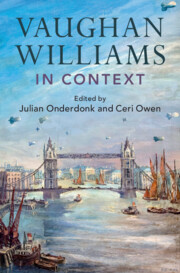Book contents
- Vaughan Williams in Context
- Composers in Context
- Vaughan Williams in Context
- Copyright page
- Dedication
- Contents
- Illustrations
- Graphs and Tables
- Musical Examples
- Notes on Contributors
- Acknowledgements
- Editorial Note
- Bibliographic Abbreviations
- Introduction
- Part I Biography, People, Places
- Chapter 1 London and the Modern City
- Chapter 2 Personality
- Chapter 3 Correspondents
- Chapter 4 Women
- Chapter 5 Friends Outside Music
- Chapter 6 Cambridge
- Part II Inspiration and Expression
- Part III Culture and Society
- Part IV Arts
- Part V Institutions
- Part VI Reception
- Further Reading
- Index of Works
- General Index
Chapter 1 - London and the Modern City
from Part I - Biography, People, Places
Published online by Cambridge University Press: 28 March 2024
- Vaughan Williams in Context
- Composers in Context
- Vaughan Williams in Context
- Copyright page
- Dedication
- Contents
- Illustrations
- Graphs and Tables
- Musical Examples
- Notes on Contributors
- Acknowledgements
- Editorial Note
- Bibliographic Abbreviations
- Introduction
- Part I Biography, People, Places
- Chapter 1 London and the Modern City
- Chapter 2 Personality
- Chapter 3 Correspondents
- Chapter 4 Women
- Chapter 5 Friends Outside Music
- Chapter 6 Cambridge
- Part II Inspiration and Expression
- Part III Culture and Society
- Part IV Arts
- Part V Institutions
- Part VI Reception
- Further Reading
- Index of Works
- General Index
Summary
Despite popular perceptions of Vaughan Williams as being focussed primarily on nature and the pastoral, a vivid appreciation of urban environments played an equally crucial role in shaping his artistic vision. A Londoner for most of his adult life, he also spent significant time in Berlin and Paris, and had a special regard for New York. Yet while he relished the bustle and rich social diversity of London, the de facto capital of the world during his lifetime, he was also keenly aware of its deprivation and dark undercurrents. A London Symphony is the most ambitious musical work to thematicize the modern city composed anywhere before 1914, and it evokes psychological and experiential tropes central to modernism’s urban imaginary across the arts, including the collision of multiple social identities, temporalities, and spatial perspectives, and the associated alienation and fragmentation of the unitary self. The composer employs an exceptionally wide range of materials, juxtaposing folk song, ragtime, street noise, and much else, in a multilayered environment of sometimes violent dissonance and rhythmic dislocation. Yet the work strives to integrate such diversity within an overarching symphonic framework – a powerful metaphor for a vision of nation and humanity that underpinned the composer’s later work.
- Type
- Chapter
- Information
- Vaughan Williams in Context , pp. 11 - 18Publisher: Cambridge University PressPrint publication year: 2024

